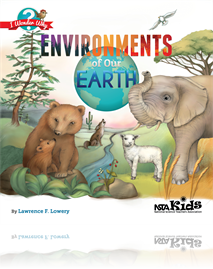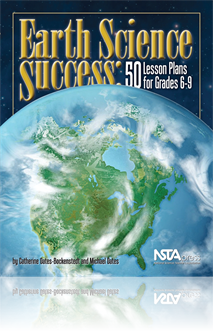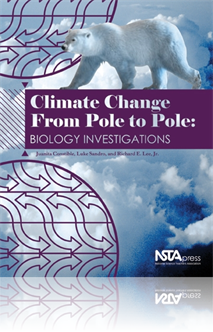Earth Science Week Resources from the National Science Teachers Association
By Lauren Jonas, NSTA Assistant Executive Director
Posted on 2013-10-11
Earth Science Week is October 13–19, 2013. Take a world tour, solve a mystery, apply to be named the Environmental Science Educator of the Year, or delve into an entire year’s worth of lessons with this resource collection from the National Science Teachers Association (NSTA).
Elementary Resources
 Environments of Our Earth: I Wonder Why: Take a world tour between the covers of a book! Environments of Our Earth guides children through six types of regions that are shaped by rainfall—or the lack thereof. Readers take a journey that starts with dense tropical rainforests and woodlands, travels through grassy savannas and prairies, and ends at dry steppes and deserts. [Read a free sample, or browse all of our kids books, many of which are also appropriate for Earth science week.]
Environments of Our Earth: I Wonder Why: Take a world tour between the covers of a book! Environments of Our Earth guides children through six types of regions that are shaped by rainfall—or the lack thereof. Readers take a journey that starts with dense tropical rainforests and woodlands, travels through grassy savannas and prairies, and ends at dry steppes and deserts. [Read a free sample, or browse all of our kids books, many of which are also appropriate for Earth science week.]
The Dynamic Earth: Recycling Naturally! This free article from the NSTA journal Science and Children provides a series of learning cycle lessons that put a new spin on rock formation.
Everyday Earth and Space Science Mysteries: What are the odds that a meteor will hit your house? Do you actually get more sunlight from Daylight Saving Time? Where do puddles go? By presenting everyday mysteries like these, this book will motivate your students to carry out hands-on science investigations and actually care about the results. [Read a free chapter: The Little Tent That Cried]
Bringing Outdoor Science In: Thrifty Classroom Lessons: When it’s just not possible to take students out to explore the natural world, bring the natural world to the classroom. Clearly organized and easy to use, this helpful guide contains more than 50 science lessons in six units: Greening the School, Insects, Plants, Rocks and Soils, Water, and In the Sky. [Read a free chapter: Rocks and Soils]
Middle School Resources
 Earth Science Success: 50 Lesson Plans for Grades 6–9: Designed as a ready-to-use survival guide for middle school Earth science teachers, this book is an invaluable resource that provides an entire year’s worth of inquiry-based and discovery-oriented Earth science lessons, including 33 investigations or labs and 17 detailed projects. [Read a free chapter: Meteorology]
Earth Science Success: 50 Lesson Plans for Grades 6–9: Designed as a ready-to-use survival guide for middle school Earth science teachers, this book is an invaluable resource that provides an entire year’s worth of inquiry-based and discovery-oriented Earth science lessons, including 33 investigations or labs and 17 detailed projects. [Read a free chapter: Meteorology]
Generating Arguments about Climate Change: In this free article from the journal Science Scope, students participate in a unit on global climate change by engaging in the process of scientific argumentation. The lessons presented in this article were created using the generate-an-argument model to help students understand climate change science.
Project Earth Science: Geology, Revised 2nd Edition: Involve students in activities that focus on how plate tectonics explain characteristics and features of Earth. The 15 hands-on, teacher-tested, classroom activities in this book use readily available materials and provide straightforward and up-to-date explanations of geologic processes and cycles.
High School Resources
 Climate Change From Pole to Pole: This volume provides an authentic and rigorous way to engage students in science and environmental issues—scientific methods, evidence, climate, and biological effects of climate change—and is a unique and essential resource for your high school or college-level classroom.
Climate Change From Pole to Pole: This volume provides an authentic and rigorous way to engage students in science and environmental issues—scientific methods, evidence, climate, and biological effects of climate change—and is a unique and essential resource for your high school or college-level classroom.
Citizen Scientists: Investigating Science in the Community: This free article from The Science Teacher journal describes numerous examples of citizen science projects that provide meaningful, authentic contexts for students to engage in the processes of science.
Earth Science Puzzles: Making Meaning From Data: Teachers of Earth and environmental sciences in grades 8–12 will welcome this activity book centered on six “data puzzles” that foster critical-thinking skills in students and support science and math standards.
Citizen Science: 15 Lessons That Bring Biology to Life, 6–12: Citizen Science offers you real-life case studies of classes that engaged in citizen science and learned authentic scientific processes and the habits of mind associated with scientific reasoning. The volume has plenty of flexibility, so you can use the lessons with or without access to field or lab facilities; whether or not your students can collect and submit data of their own; and inside your classroom or outside through fieldwork in schoolyards, parks, or other natural areas in urban or rural settings. [Read a free chapter: Bird Migration Patterns in My Area]
General Support for K-12 Educators
Apply for the SeaWorld Parks & Entertainment Outstanding Environmental Science Educator of the Year Award: This $10k award recognizes the outstanding efforts of students, teachers, and community leaders across the country, who are working at the grass roots level to protect and preserve the environment. The winner will receive $10,000 and an expense paid trip to attend the NSTA National Conference. The deadline is November 30, 2013. Find a complete application and more information here.
Earth, Sun, and Moon: General Characteristics of Earth: This FREE, two-hour, online interactive inquiry-based content module helps teachers better understand the science content they teach. This Science Object is the first of four Science Objects in the Earth, Sun, and Moon SciPack. It provides an understanding of how the different spheres (atmosphere, lithosphere, and hydrosphere) of Earth interact and why each plays an important role in making Earth the only planet with the conditions necessary for life. Earth is approximately spherical in shape like all planets and stars. Earth is composed mostly of rock. Three-fourths of its surface is covered by a relatively thin layer of water (some of it frozen), and the entire planet is surrounded by a relatively thin blanket of air.
Looking for more? Search among more than 6,000 resources, quality professional development opportunities (many of which are free), and management and reporting tools. The NSTA Learning Center can help with your professional development needs. To check out The NSTA Learning Center, click here.
Disclaimer: The views expressed in this blog post are those of the author(s) and do not necessarily reflect the official position of the National Science Teaching Association (NSTA).


